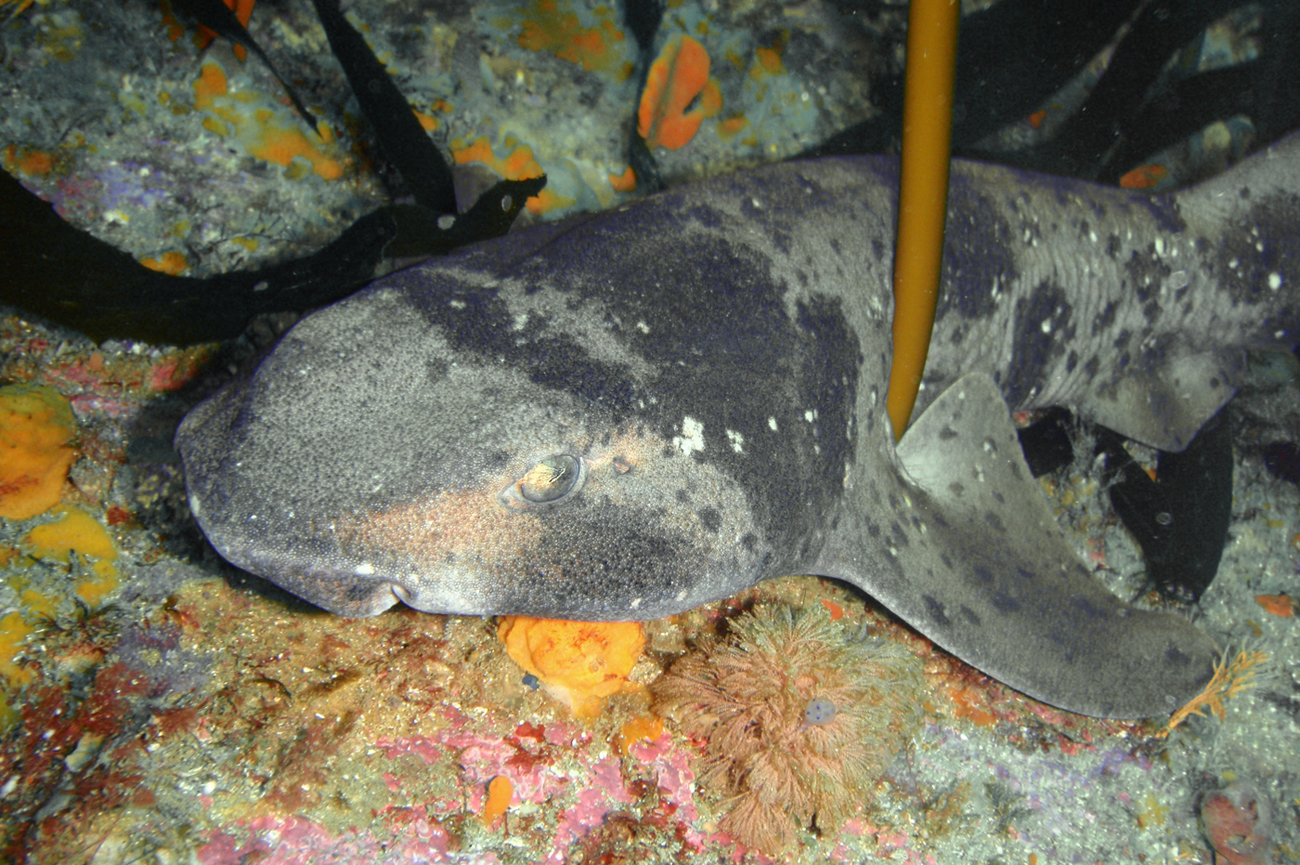Draughtboard Shark, Cephaloscyllium laticeps (Duméril 1853)

A Draughtboard Shark, Cephaloscyllium laticeps, at Mistaken Cape, Maria Island, Tasmania, February 2014. Source: Peter Southwood / Wikimedia Commons. License: CC by Attribution-ShareAlike
A robust brownish to greyish swell shark with a broad dark saddle behind the eyes, and a dense array of irregular very dark spots, blotches and saddles, sometimes with paler flecks on the body. Small juveniles have small dark spots and faint saddle-like blotches, and larger juveniles have darker saddles only.
When disturbed or threatened, swell sharks increase their size by inflating their stomachs with air or water in an attempt to avoid predation.
Video of an Australian Fur Seal playing with a Draughtboard shark and a Common Seadragon at Flinders Pier, Western Port, Victoria.
Video of a Draughtboard Shark and eggcase in Tasmania
Video of a Draughtboard Shark (plus Southern Hulafish and a Bluethroat Wrasse) at a baited camera off Woodbridge Jetty, Tasmania.
Video of harmless Swell Sharks in Port Phillip Bay - easily attracted to bait and sometimes ill-treated by local anglers.
Draughtboard Shark, Cephaloscyllium laticeps (Duméril 1853)
More Info
|
Distribution |
Endemic to temperate waters of southern Australia, from Jervis Bay (New South Wales) around southern Australia including Tasmania, to the Recherche Archipelago (Western Australia). A bottom-dwelling shark found on sandy bottoms and rocky reefs in bays, harbours and along the coast in depths to 60 m. |
|
Features |
Vertebrae 110-116 (precaudal 76-81); Jaw teeth (upper) 38 | 38; Jaw teeth (lower) 27 | 27. Body robust. Teeth very small, multicuspidate. Front margin of pectoral fin longer than the distance between the pectoral fin insertion on underside of body and the origin of the pelvic fin. |
|
Size |
Length to 1 metre in total length. |
|
Colour |
Medium brown to greyish dorsally; ornamented with a dense array of irregular dark blotches; a broad dark saddle between eye and pectoral origin; dark below eye; ventral surface mostly pale; small juveniles with small dark spots and faint saddle-like blotches, larger juveniles with darker saddles only, and adults with very dark spots, blotches and saddles (sometimes with a few pale flecks) and normally with a dark stripe on midline of belly. |
|
Feeding |
Feeds on small fishes, squid, and crustaceans. Individuals are known to enter crayfish traps in search of easy prey. |
|
Biology |
Females lay pale yellowish flask-shaped egg cases (13 cm lones g, 5 cm wide) with 19-27 strong, transverse ridges and long spiral tendrils that attach to seaweed or sessile invertebrates in the bottom. The young hatch after about 12 months. Males mature at 82 cm; size at birth ~14 cm. |
|
Fisheries |
Draughtboard sharks form a significant part of the bycatch in the southern gillnet fishery. They are usually released and mortality appears to be low. Although the species is of little commercial value, it has recently been marketed in some areas. |
|
Conservation |
|
|
Species Citation |
Scyllium laticeps Duméril 1853, Revue et Magasin de Zoologie (2) 5 :84, Pl. 3 (figs. 2a-b). Type locality: New Holland (Tasmania) Australia. |
|
Author |
William T. White & Dianne J. Bray |
|
Resources |
Draughtboard Shark, Cephaloscyllium laticeps (Duméril 1853)
References
Compagno, L.J.V. 1984. FAO Species Catalogue. Sharks of the World. An annotated and illustrated catalogue of shark species known to date. Carcharhiniformes. FAO Fisheries Synopsis No. 125. Rome : FAO Vol. 4(2) 251-655 pp. (p. 300 as C. nascione in part)
Compagno, L.J.V., Dando, M. & Fowler, S. 2005. A Field Guide to the Sharks of the World. London : Collins 368 pp.
Daley, R.K., Stevens, J.D., Last, P.R. & Yearsley, G.K. 2002. Field Guide to Australian Sharks & Rays. Hobart : CSIRO Marine Research 84 pp.
Duméril, A.H.A. 1853. Monographie de la tribu des scylliens ou roussettes (poissons plagiostomes) comprenant deux espèces nouvelles. Revue et Magasin de Zoologie (Paris) 2 5: 8-25 73-87 119-130 pl. 3.
Grant, E.M. 2002. Guide to Fishes. Redcliffe : EM Grant Pty Ltd 880 pp. (as Cephaloscyllium nascione)
Kuiter, R.H. 1993. Coastal Fishes of South-eastern Australia. Bathurst : Crawford House Press 437 pp.
Last, P.R. & Stevens, J.D. 1994. Sharks and Rays of Australia. Canberra : CSIRO Australia 513 pp. 84 pls
Last, P.R. & Stevens, J.D. 2009. Sharks and Rays of Australia. Collingwood : CSIRO Publishing Australia 2, 550 pp.
Macbeth, W.G., Vandenberg, M. & Graham, K.J. 2008. Identifying Sharks and Rays; a Guide for Commercial Fishers. Sydney : New South Wales Department of Primary Industry 71 pp.
Springer, S. 1979. A revision of the catsharks, family Scyliorhinidae. National Marine Fisheries Service (U.S.). Technical Report 422: 1-152 figs 1-97.
Stevens, J.D. 1994. Families Carcharhinidae, Triakidae, Scyliorhinidae. pp. 120-138 figs 76-107 in Gomon, M.F., Glover, C.J.M. & Kuiter, R.H (eds). The Fishes of Australia's South Coast. Adelaide : State Printer 992 pp. 810 figs (as Cephaloscyllium nascione in part)
White, W. 2008. Shark Families Heterodontidae to Pristiophoridae. pp. 32-100 in Gomon. M.F., Bray, D.J. & Kuiter, R.H (eds). Fishes of Australia's Southern Coast. Sydney : Reed New Holland 928 pp.
Whitley, G.P. 1932. Studies in Ichthyology No. 6. Records of the Australian Museum 18(6): 321-348 figs 1-3 pls 36-39 [324, fig. 2.2] [as Cephaloscyllium isabella nascione in part]
















